Fishipedia Report: Roosterfish – the beauty of the beast
Fishipedia’s editor, Rory Batho, gets up close and personal with one of the finest-looking game fish in the sea – the big, bad roosterfish…
 As the captain cuts the engine and the boat eases into a lazy drift, we start scanning for signs of life in the gently undulating Pacific. At first glance it looks peaceful enough – the reality of course (particularly when you’ve got roosterfish on your mind), is something else.
As the captain cuts the engine and the boat eases into a lazy drift, we start scanning for signs of life in the gently undulating Pacific. At first glance it looks peaceful enough – the reality of course (particularly when you’ve got roosterfish on your mind), is something else.
It was roughly at this moment (and not for the first time) that I started thinking: you have to feel for the lesser fish species sometimes. Anchovies, pilchards, sardines – anglers in these parts seldom stop long enough to ascertain their true identity, filing them conveniently under one catch-all category: baitfish. Now there’s a precursor to doom if ever there was one.
But if you’ve fished along the Pacific coast of Central America, you’ll know that, sadly for these guys, it’s a name well deserved. Standard procedure goes a little something like this: once a skipper has identified a likely spot, he’ll kill the engine, pick a handful of baits from the live well and start casually scattering them across the surface of the water. It’s vaguely reminiscent of a farmer tossing corn to hens; the outcome, however, is altogether more explosive.
If all goes to plan, the sound of bait raining down on the surface is interpreted as a sort of aquatic alarm bell by predatory fish in the vicinity – jacks, roosterfish, dorado and snapper hopefully – which will promptly come torpedoing in from all angles and crashing into the hapless six-inchers.
The last thing they might see is a black comb, hoisted high like a pirate’s black flag, cutting through the water towards them. The ensuing melée is usually swift and decisive, and no quarter is given.
As the fisherman, it’s your job to capitalise on the chaos, introducing a baited hook, lure or fly to the proceedings at just the right moment and diverting the rampaging hoards towards your offering as best you can.
 Such is the diversity of predatory activity in areas like this, there’s no certainty that roosters will be the first to the party. Jacks, the blunt-faced bullies of inshore waters, are usually first on the scene, their aggression getting the better of them time and again. Despite their ferocious appetite, awesome power and drag-melting speed out of the blocks, there’s no denying that their place here is on the undercard, often being viewed as something of a nuisance by those in search of their more glamorous siblings.
Such is the diversity of predatory activity in areas like this, there’s no certainty that roosters will be the first to the party. Jacks, the blunt-faced bullies of inshore waters, are usually first on the scene, their aggression getting the better of them time and again. Despite their ferocious appetite, awesome power and drag-melting speed out of the blocks, there’s no denying that their place here is on the undercard, often being viewed as something of a nuisance by those in search of their more glamorous siblings.
Sierra mackerel will usually make an appearance too. Again, they’re not nearly as popular as their credentials suggest they should be: blistering speed, bloodlust and wicked dentistry are not enough to elevate this species to any kind of top billing.
Round here there’s no competition – the rooster rules.
Pursuing them on the beaches is one thing – since the seminal roosterfish film “Running Down the Man” came out, people have developed the mistaken notion that all you have to do is fly down to Cabo, jump in the beach buggy, bust out the 10-weight and let the mayhem begin. If only. The fact is you can go for days without seeing fish if you’re looking in the wrong place, and sometimes, even when you can see them, they’re tantalisingly out of reach.
The other option is to hunt them from a panga. Aside from the obvious advantage of covering more ground, and being able to chase down busting fish, it’s the only effective way of chumming them in. Sure, it’s not as sporting as pursuing them in the surf with a fly rod, but it’s a lot of fun when time is at a premium. And time was most definitely at a premium. I had a half day to make it happen.
 We drifted around likely-looking structure, the skipper manouvering the little pink craft to within wincing distance of offshore islands and submerged rocks. Predictably enough, sierras were first on the scene, followed by the ubiquitous jacks. But on this particular day, the black comb was conspicuous by its absence. All the while, Jeffrey remained upbeat. “We find pez gallo,” he reassured me on more than one occasion, “no problem”. I’m not sure why, but I don’t think I ever disbelieved him.
We drifted around likely-looking structure, the skipper manouvering the little pink craft to within wincing distance of offshore islands and submerged rocks. Predictably enough, sierras were first on the scene, followed by the ubiquitous jacks. But on this particular day, the black comb was conspicuous by its absence. All the while, Jeffrey remained upbeat. “We find pez gallo,” he reassured me on more than one occasion, “no problem”. I’m not sure why, but I don’t think I ever disbelieved him.
Nevertheless, even his casual confidence was replaced by something bordering on urgency when, as the afternoon drew to a close, the star guest arrived. “Gallogallogallo!” shouted Jeffrey, as my live bait disappeared in a boil of water in the distance.
As with such occasions, you seldom remember much of the fight itself. I recall those first few moments in vivid detail; the realisation that, at long last, I was hooked up to the fish I’d spent so many nights dreaming of. I’m pretty sure I said a little prayer at some point. And I know I swore a lot when it eventually came to the boat. At 20lbs or so, it was far larger than I could reasonably have expected my first rooster to be.
But more than that, it was the exquisite beauty of it that struck me – the jack-but-more-handsome face, the dark bars that transition from a vertical pattern on the head to a tapering horizontal swipe towards the big sickle tail, and of course, that beautiful dorsal arrangement. The first segment of the comb, with its mottled greenish hue, is a nice outline of the sort of fin one might normally expect to discover on a fish. The rest looks like some kind of artistic flourish, giving the rooster a dandyish appearance entirely at odds with his pugnacious personality.
We’ve all got the bad-taste “trophy” photos in our collection. If there was an easy way of discovering which of mine are the “most viewed”, I wouldn’t be in the least bit surprised if this one was right at the top:

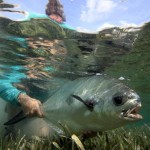

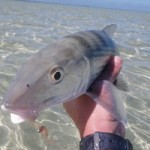
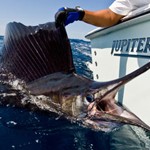
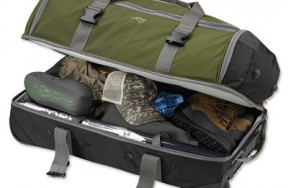
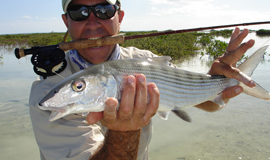
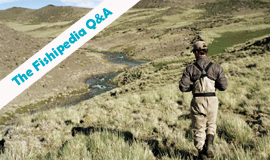
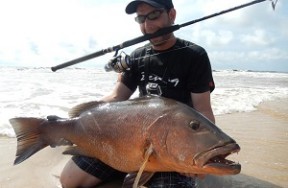
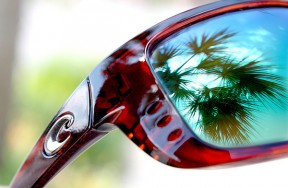
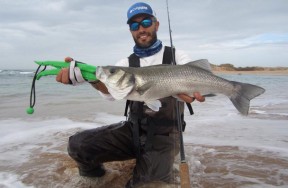
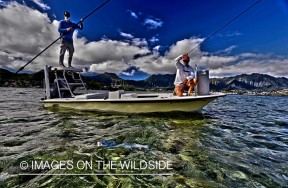
Where did you fish?
It looks a lot like Quepos/Manuel Antonio in Costa Rica.
Well spotted, sir! That’s exactly where it was – just out of Quepos…